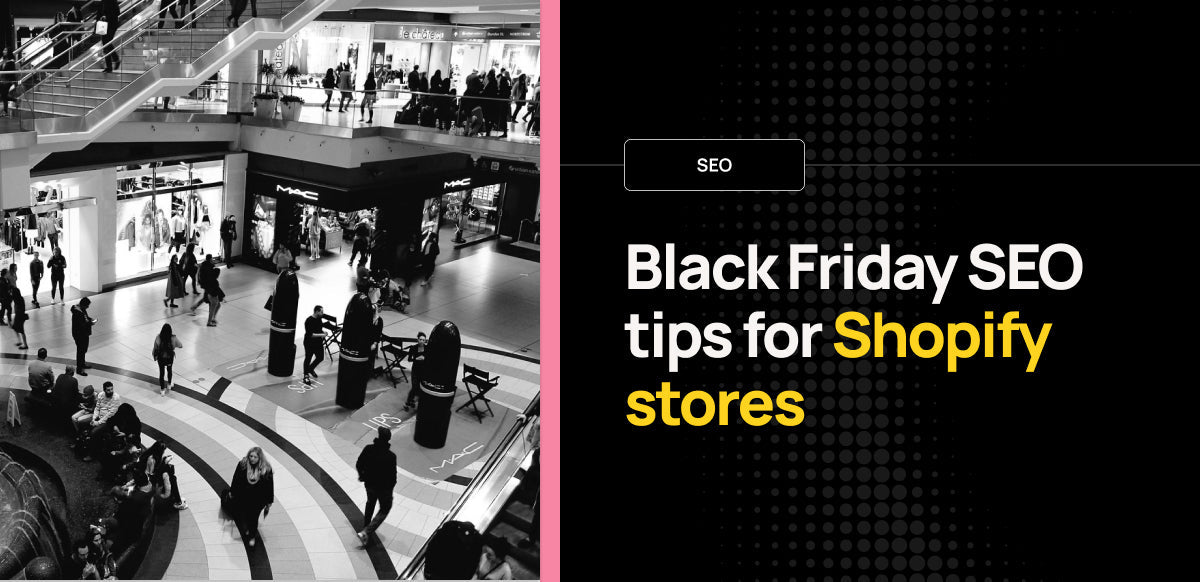Blog / Black Friday SEO tips for Shopify stores
Black Friday SEO tips for Shopify stores

Black Friday isn’t a single-day flash sale anymore. For many brands it now runs for weeks - and it’s not just for high-street retailers with queues at 6am. Online stores take a large share of the revenue.
That creates meaningful upside. The question is whether your ecommerce store is set up to capture it.
Below is a practical approach to building a Black Friday SEO plan that performs during the peak and strengthens your site for the long term.
Start with a dedicated Black Friday landing page
Create a Black Friday (or BFCM) landing page that acts as the hub for your seasonal activity. Treat it as an evergreen asset you’ll refine each year.
Your page should:
- Use an evergreen URL (e.g.
/black-friday, not/black-friday-2025) - Be clearly linked from your main navigation (ideally top level)
- Include a countdown timer (see our custom Black Friday timer)
- Be optimised for specific BFCM terms related to your products (you’re unlikely to rank for “Black Friday” alone)
- Include clear, relevant copy and FAQs
- Capture email addresses ahead of launch - segment if you can and reward early subscribers
Use this page as the single source of truth for all campaigns. Sending ads, social and email traffic to one hub simplifies the customer journey and makes ROI analysis cleaner.
Strategy: building the right page structure
A common challenge is avoiding keyword cannibalisation with evergreen collections. For example, “Black Friday dresses” should support - not compete with - your core “Dresses” collection.
Build with intent. Validate seasonal demand with tools like Ahrefs and Google Trends, target terms that are genuinely BFCM-specific, and make the hierarchy clear. Use strong taxonomy and internal linking from sub-collections back to the main collection to signal that these pages form part of a topical cluster rather than duplicates.
Timing matters. Don’t wait until November to publish. Google needs time to crawl and understand new content. Launch your BFCM pages well in advance, keep them out of menus and campaigns until closer to the date, and let search engines build familiarity before the surge.
If you’re a smaller or niche brand, competing on broad Black Friday head terms is rarely realistic. Focus on long-tail, product-led queries tied to your USP - for example, “Black Friday vegan skincare sets” or “Black Friday handmade leather wallets”. Depth typically beats breadth, particularly when your brand positioning is clear.
One page - or more?
A single Black Friday hub is essential, but it may not be enough. Think about how customers search for your products. A fashion brand will see significant November demand for terms like:
- Black Friday jumpers
- Black Friday dresses
- Black Friday jeans
As with your core site, consider a seasonal taxonomy to capture these searches. Start with the hub, then build sub-collections based on stock, margins and demand. Improve them each year rather than starting from scratch.
Technical SEO: avoiding common pitfalls
Avoid creating a brand-new Black Friday page every year. That resets authority, introduces duplication and breaks internal links. Stick to one evergreen URL you refresh annually. It compounds equity and simplifies operations.
Watch for thin content. A product grid with “Black Friday 2025” in the title won’t carry its weight. Add helpful copy, FAQs and structured data so the page serves customers and search engines.
After the event, don’t delete or de-index sub-collections. Keep them live and update the messaging and links to retain users on-site. For example: “Black Friday 2025 is over - check back next year. In the meantime, browse our sale items.” This preserves equity, avoids 404s and keeps your taxonomy stable.
Structured data can help you stand out. Add FAQ, Product and Offer schema to improve eligibility for rich results and organic shopping features. During BFCM, every enhancement in the SERP helps.
Don’t forget about on-site search
For Shopify stores, set up search bar redirects.
If someone types “black friday” into site search, send them to your optimised landing page rather than the default results. Handle common typos too - a query like “black froday” should still reach the hub. Apps like Algolia make this straightforward, and you can implement code-based solutions if you prefer. Small improvements like this rescue sessions and conversions.
Digital PR: win backlinks through Black Friday coverage
Black Friday is one of the few moments when national titles, lifestyle sites and niche publishers actively seek deals to feature. It’s a strong opportunity to earn authoritative links to seasonal collections, which supports both short-term visibility and long-term growth.
One reliable angle is inclusion in “Best Black Friday [product type]” round-ups. Journalists and affiliates publish curated lists across most categories. If your hub or a relevant sub-collection is the best destination for those deals, you have a good chance of inclusion - and often a direct link.
To increase your hit rate:
- Build and pitch early - many lists are compiled weeks in advance
- Provide assets upfront - product details, pricing, high-res images and timelines
- Target niche publishers as well as nationals - smaller sites often link directly to collections
- Pitch sub-collections as well as the hub - “Black Friday dresses” or “Black Friday vegan skincare sets” are often a better fit for round-ups
This drives referral traffic during the sale and compounds authority year after year as your evergreen hub earns placements.
Aligning UX and marketing
Page speed always matters, but during BFCM it becomes critical. Even if your platform can handle spikes, pages weighed down by heavy images, autoplay video or intrusive pop-ups will slow. With urgency high, small delays cost orders. Keep the experience lean and fast.
Use the Black Friday page as a lead capture engine. You’ll attract pre-sale traffic from search in the weeks before launch. Don’t let those users bounce when they realise the sale isn’t live. Offer email sign-up or early access. This builds a warm audience you can convert the moment the sale starts.
Final thoughts
Black Friday is a major trading window, but competition is intense. Success comes from treating your pages as evergreen assets, avoiding common technical issues, aligning with your broader marketing plan and converting early interest into customers.
With the right structure and timing, your Black Friday hub and sub-collections will capture this year’s demand and strengthen year-on-year.








